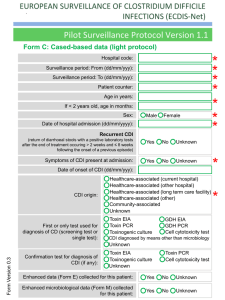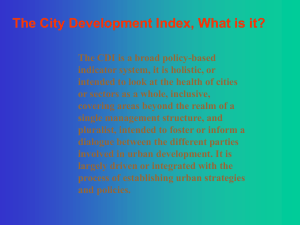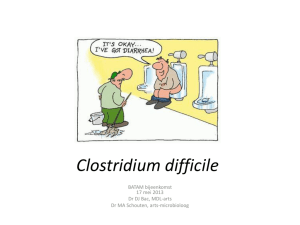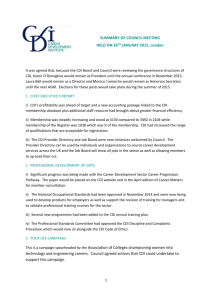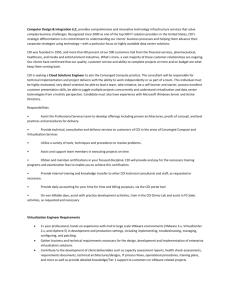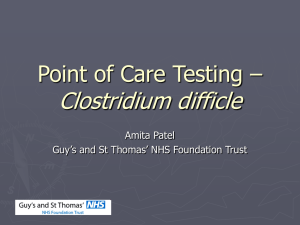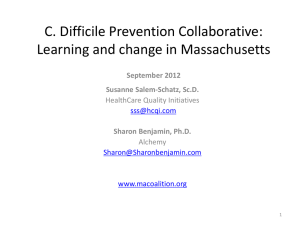treatment of recurrent cdi
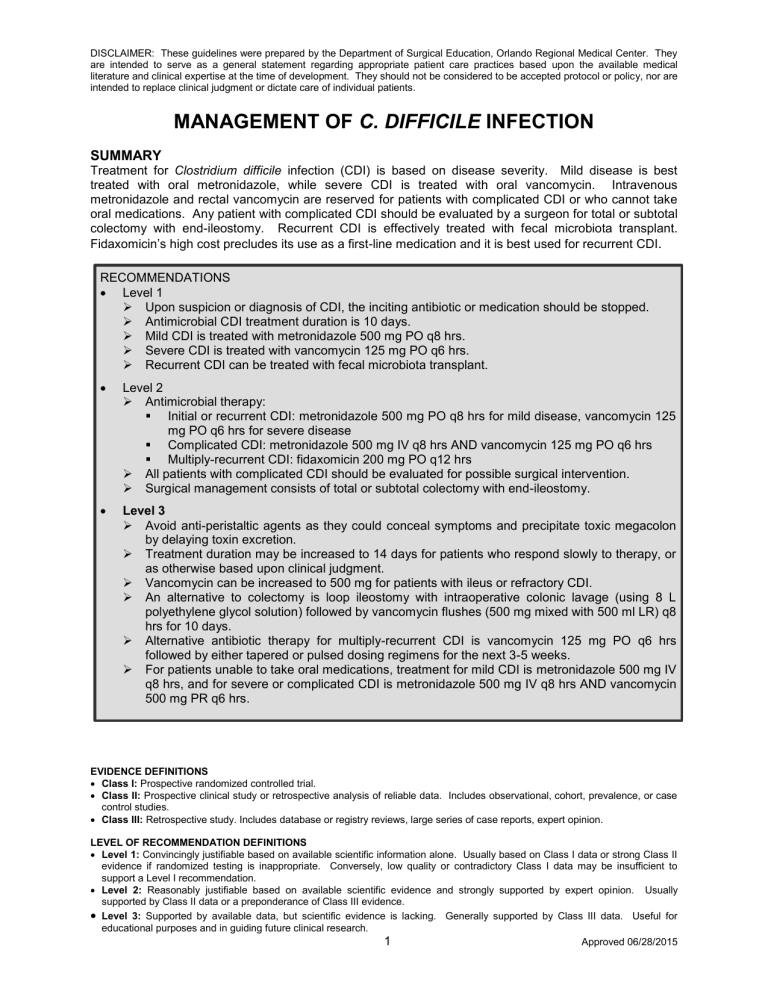
DISCLAIMER: These guidelines were prepared by the Department of Surgical Education, Orlando Regional Medical Center. They are intended to serve as a general statement regarding appropriate patient care practices based upon the available medical literature and clinical expertise at the time of development. They should not be considered to be accepted protocol or policy, nor are intended to replace clinical judgment or dictate care of individual patients.
MANAGEMENT OF C. DIFFICILE INFECTION
SUMMARY
Treatment for Clostridium difficile infection (CDI) is based on disease severity. Mild disease is best treated with oral metronidazole, while severe CDI is treated with oral vancomycin. Intravenous metronidazole and rectal vancomycin are reserved for patients with complicated CDI or who cannot take oral medications. Any patient with complicated CDI should be evaluated by a surgeon for total or subtotal colectomy with end-ileostomy. Recurrent CDI is effectively treated with fecal microbiota transplant.
Fidaxomicin ’s high cost precludes its use as a first-line medication and it is best used for recurrent CDI .
RECOMMENDATIONS
Level 1
Upon suspicion or diagnosis of CDI, the inciting antibiotic or medication should be stopped.
Antimicrobial CDI treatment duration is 10 days.
Mild CDI is treated with metronidazole 500 mg PO q8 hrs.
Severe CDI is treated with vancomycin 125 mg PO q6 hrs.
Recurrent CDI can be treated with fecal microbiota transplant.
Level 2
Antimicrobial therapy:
Initial or recurrent CDI: metronidazole 500 mg PO q8 hrs for mild disease, vancomycin 125 mg PO q6 hrs for severe disease
Complicated CDI: metronidazole 500 mg IV q8 hrs AND vancomycin 125 mg PO q6 hrs
Multiply-recurrent CDI: fidaxomicin 200 mg PO q12 hrs
All patients with complicated CDI should be evaluated for possible surgical intervention.
Surgical management consists of total or subtotal colectomy with end-ileostomy.
Level 3
Avoid anti-peristaltic agents as they could conceal symptoms and precipitate toxic megacolon by delaying toxin excretion.
Treatment duration may be increased to 14 days for patients who respond slowly to therapy, or as otherwise based upon clinical judgment.
Vancomycin can be increased to 500 mg for patients with ileus or refractory CDI.
An alternative to colectomy is loop ileostomy with intraoperative colonic lavage (using 8 L polyethylene glycol solution) followed by vancomycin flushes (500 mg mixed with 500 ml LR) q8 hrs for 10 days.
Alternative antibiotic therapy for multiply-recurrent CDI is vancomycin 125 mg PO q6 hrs followed by either tapered or pulsed dosing regimens for the next 3-5 weeks.
For patients unable to take oral medications, treatment for mild CDI is metronidazole 500 mg IV q8 hrs, and for severe or complicated CDI is metronidazole 500 mg IV q8 hrs AND vancomycin
500 mg PR q6 hrs.
EVIDENCE DEFINITIONS
Class I: Prospective randomized controlled trial.
Class II: Prospective clinical study or retrospective analysis of reliable data. Includes observational, cohort, prevalence, or case control studies.
Class III: Retrospective study. Includes database or registry reviews, large series of case reports, expert opinion.
LEVEL OF RECOMMENDATION DEFINITIONS
Level 1: Convincingly justifiable based on available scientific information alone. Usually based on Class I data or strong Class II evidence if randomized testing is inappropriate. Conversely, low quality or contradictory Class I data may be insufficient to support a Level I recommendation.
Level 2: Reasonably justifiable based on available scientific evidence and strongly supported by expert opinion. Usually supported by Class II data or a preponderance of Class III evidence.
Level 3: Supported by available data, but scientific evidence is lacking. Generally supported by Class III data. Useful for educational purposes and in guiding future clinical research.
1 Approved 06/28/2015
DEFINITIONS
Clostridium difficile infection (CDI) is diagnosed by the presence of at least one of the following (1):
1. Signs and symptoms of CDI plus microbiological evidence of infection (toxin or toxin-producing bacteria) with no other identifiable cause
2. Pseudomembranous colitis as seen on colonoscopic examination or pathological specimens
The signs and symptoms of CDI comprise three different clinical manifestations: diarrhea, ileus, and toxic megacolon (1). Diarrhea is defined as loose or watery stool that takes the shape of the collecting receptacle at least three times in a 24-hour period, or more frequently than is normal for the patient. Ileus is characterized by vomiting, constipation or obstipation, and/or radiographic evidence of dilated bowel.
This presentation of CDI is seen in less than one percent of affected patients (2). Toxic megacolon is diagnosed when the colon is more than six centimeters in transverse dimension on imaging and there are signs of a severe systemic inflammatory response.
Disease due to CDI is classified as mild, severe, or complicated (2,3). Complicated disease is sometimes referred to as fulminant. The characteristics of each classification are summarized below.
Mild
WBC < 15 x 10 3 /ul
AND
Cr < 1.5 x baseline OR albumin ≥ 3 g/dl
Severe
(any criterion)
WBC > 15 x 10 3 /ul
Cr ≥ 1.5 x baseline
Albumin < 3 g/dl
Abdominal tenderness
Systemic signs of infection
Complicated
(any criterion)
WBC ≥ 35 10 3 /ul or < 2 10 3 /ul
Lactate > 2.2 mmol/l
Temperature > 38.5 o C
Ileus or significant abdominal distention
Megacolon (> 6 cm wide on imaging)
Hypotension/shock due to CDI
ICU admission due to CDI
End organ failure due to CDI
Recurrent CDI is defined as disease that recurs within eight weeks of treatment completion and symptom resolution (3). Up to 35% of patients treated for CDI experience a recurrence, and 65% of these patients will have multiply-recurrent disease (4). It is not possible to distinguish clinically between disease due to relapse of the initial infection or that due to reinfection with a new strain of Clostridium difficile . Therefore, the terms recurrence and relapse are often interchangeable.
TREATMENT OF MILD CDI
Three randomized controlled trials have shown that metronidazole and vancomycin are equally effective in treating mild cases of CDI (5-7). The sentinel study by Teasley et al. in 1983 randomized 101 patients to oral metronidazole or oral vancomycin and found non-significant differences in response and relapse rates (5). In 1996, Wenisch et al. compared four treatment regimens – metronidazole, vancomycin, teicoplanin, and fusidic acid (6). Metronidazole and vancomycin had equivalent rates of response (94%) and recurrence (16%). A pivotal randomized controlled trial by Zar et al. in 2007 compared the two antibiotics and stratified the data by disease severity (7). For mild CDI, metronidazole and vancomycin achieved similar cure rates (90% and 98% respectively). This difference was not statistically significant
(p=0.36). Metronidazole is preferred over vancomycin due to the significant difference in cost. On average, oral vancomycin is fifty-fold more expensive than oral metronidazole (3,5). Patients who are
2 Approved 06/28/2015
unable to take metronidazole, due to intolerance/allergy or pregnancy/breastfeeding, can be effectively treated with vancomycin.
In 2011, the FDA approved a new antibiotic for the treatment of CDI, fidaxomicin. Several randomized controlled trials have supported its effectiveness in patients with mild CDI (8, 9). Louie et al. conducted a non-inferiority study of fidaxomicin versus vancomycin and found comparable cure rates among 548 patients (88% vs. 86% respectively) (9). A similar study was performed by Cornely et al. in 509 patients, with similar results (88% resolution with fidaxomicin vs. 87% with vancomycin) (8). However, fidaxomicin is an expensive drug (up to four times the cost of vancomycin (3)), and an economic analysis by Bartsch et al. determined that it is not cost-effective as first-line treatment for mild CDI (10).
TREATMENT OF SEVERE CDI
Oral vancomycin is the preferred therapy for severe CDI, a recommendation that is based largely on a randomized controlled trial by Zar et al. that compared metronidazole and vancomycin and stratified the patients by disease severity (7). For patients with severe CDI, vancomycin was significantly more effective than metronidazole (97% cure vs. 76%, p=0.02). The dose of vancomycin used in this study was 125 mg, and no prospective studies support the use of higher dosages. One randomized controlled trial compared regimens with 125 mg and 500 mg and found similar efficacy for both (11). The results of this study were not stratified by disease severity, however. Expert opinion favors using higher doses of oral vancomycin for more severe or recalcitrant cases of CDI (12). Anecdotally, fidaxomicin has been used to treat severe CDI. However, there are no randomized controlled trials of fidaxomicin treatment in patients with severe or complicated CDI.
TREATMENT OF COMPLICATED CDI
Surgery is the best treatment for complicated or fulminant CDI. The perioperative mortality, however, is significant and can reach up to 80% in some reports. The more severe the patient’s disease at the time of surgery, the higher the mortality. Other risk factors for post-operative mortality include lactate > 5 mmol/l, mental status changes, need for vasopressors, need for intubation, and other signs of end organ failure (1).
3 Approved 06/28/2015
INDICATIONS FOR SURGERY
Five days of unsuccessful medical therapy
WBC > 50 x 10 3 /ul
Lactate > 5 mmol/l
Sepsis
Peritonitis
Perforation
Mental status changes
Shock
Respiratory failure
Renal failure
Abdominal compartment syndrome
Unexplained clinical deterioration
The most comprehensive review to-date of surgery for CDI comes from the Eastern Association for the
Surgery of Trauma (EAST) (13). A systematic review of the literature identified 32 relevant studies, none of which were randomized and only two of which were prospective. Based on this review, the current
EAST practice guidelines recommend early intervention with total or subtotal colectomy. A meta-analysis of eight of the studies found that early surgery, defined as before the onset of shock, can reduce the risk of mortality by up to 50%. As it is difficult to predict when a patient will progress to shock, some authors recommend surgical evaluation after five days of medical therapy with no improvement or worsening of the patient’s clinical status (13,14). Other published indications for surgery are WBC > 50 x 10 3 /ul, lactate
> 5 mmol/l, sepsis, peritonitis, perforation, mental status changes, shock, respiratory failure, renal failure, abdominal compartment syndrome, or any unexplained clinical deterioration (14). Currently, there are no validated scoring systems to predict which patients will respond to medical therapy and which will ultimately require surgery.
When complicated CDI is managed with surgery, the recommended procedure is total colectomy with end-ileostomy. This is the safest and most definitive option for patients with complicated CDI who are often critically ill. If a total colectomy is not feasible, a subtotal may be performed. Following a subtotal colectomy, some surgeons prescribe a seven-day course of intravenous metronidazole to treat any residual disease in the rectum (15).
Unfortunately, due to the high morbidity and mortality associated with surgery for CDI, surgical evaluation is often delayed. Less morbid procedures may encourage earlier consideration for surgery. One such procedure currently under investigation is a loop ileostomy with colonic lavage. Although available evidence to-date is limited to case series and anecdotal data, the results have been promising. The procedure involves the creation of a loop ostomy in the terminal ileum, intra-operative antegrade lavage of the colon using a polyethylene glycol 3350/electrolyte solution (GoLytely), and post-operative antegrade colonic flushing with a vancomycin solution. Intravenous metronidazole is often administered post-operatively. The pathophysiologic basis of this procedure is three-fold (14). The loop ileostomy diverts the enteric stream and deprives the Clostridium difficile bacteria of nutrients. The intra-operative high-volume lavage mechanically reduces bacterial and toxin concentrations in the colon. The postoperative lavage and intravenous metronidazole are synergistic in eliminating remaining bacteria.
Thus far, Neal and colleagues have provided the strongest evidence of the effectiveness of loop ileostomy with colonic lavage (16), after treating 42 patients with complicated CDI with this procedure.
Creation of the loop ileostomy was achieved laparoscopically in a majority of patients (35 patients, 83% percent of the cohort), while 7 patients required conversion to an open procedure. Intra-operative lavage was performed using eight liters of warmed GoLytely solution. A 24 French Malecot catheter was inserted into the distal limb of the loop ileostomy for post-operative delivery of vancomycin flushes using
500 mg in 500 ml of Lactated Ringer ’s solution every eight hours for ten days. Post-operatively, patients received a ten-day course of 500 mg of intravenous metronidazole every eight hours. 39 patients (93% of the cohort) were successfully treated with this procedure, while three patients ultimately required a colectomy. All 39 patients had resolution of their CDI. 30-day mortality in the cohort was 19%, compared
4 Approved 06/28/2015
to 50% in a group of historical controls (p = 0.006). Of the patients who were followed for six months afterwards, 79% had their ileostomy reversed. Among the controls, only 19% were reversed. However, recurrence of CDI after reversal of the ileostomy remains unknown. More rigorous and reproducible data with longer follow-up may eventually establish ileostomy with colonic lavage as the standard of care for surgical management of CDI.
For patients with complicated CDI who cannot or will not undergo surgery, the Infectious Diseases
Society of America (IDSA) recommends dual therapy with both metronidazole and vancomycin (2).
Because of the likelihood of ileus or megacolon and the resultant possibility of oral medications not effectively reaching the colon, intravenous metronidazole is recommended. In addition, due to its proven efficacy for severe CDI, vancomycin is also recommended. Oral formulations of vancomycin are preferred over rectal, though both risk incomplete passage through the colon. Intravenous vancomycin is not efficacious for the treatment of CDI.
TREATMENT FOR PATIENTS AT RISK FOR RECURRENCE
Risk factors for recurrent CDI include age > 65 years, presence of severe comorbidities such as renal failure, continued antibiotic use, proton pump inhibitor use, increasing severity of the initial episode, and previous recurrence (1).
RISK FACTORS FOR RECURRENCE
Age > 65 years
Severe comorbidities
Continued antibiotic use
Continued PPI use
Severe or complicated CDI
History of recurrence
Immunosuppression
For patients at risk for recurrence, fidaxomicin therapy may be the most appropriate therapy. The randomized controlled trial conducted by Louie et al. revealed that while both fidaxomicin and vancomycin were equally effective in treating CDI, there were significantly fewer recurrences in the fidaxomicin group than in the vancomycin group (15% vs. 25%, p=0.005) (9). Although this is class I evidence, the trial was not designed to evaluate treatment specifically for patients at high risk for recurrence. An adjuvant study using the same cohort of patients provided a possible explanation for the observed decrease in recurrence by showing that fidaxomicin preserved intestinal microbiota better than vancomycin did (17).
At Orlando Health, approved indications for fidaxomicin therapy are 1) first recurrence with high risk of second recurrence, or 2) second recurrence within sixty days. Patients are at high risk of second recurrence if they have at least two of the following: age > 65 years, immunosuppression, receipt of broad-spectrum antibiotics in the preceding sixty days, or moderate to severe disease. Fidaxomicin should be given for ten days only.
TREATMENT OF RECURRENT CDI
There are no randomized controlled trials specifically involving patients with recurrent CDI.
Regarding medical therapy for the first recurrence (second episode) of CDI, current guidelines from both the IDSA and the European Society of Clinical Microbiology and Infectious Diseases (ESCMID) state that treatment follows the same principles as for the initial episode. That is, it should be based on severity
(1,2). This recommendation comes from randomized controlled trials of primary CDI (7,9,18-20), and the finding that recurrence was similar regardless of the medication given. For example, in the study by Zar et al., recurrence after metronidazole therapy was 15% and after vancomycin was 14% (7). Although patients suffering from recurrent CDI are at increased risk for further recurrences, either metronidazole or
5 Approved 06/28/2015
vancomycin can be given since neither was superior in preventing recurrence. Metronidazole is the preferred antibiotic for mild CDI, and vancomycin for severe CDI.
For patients with multiply-recurrent CDI, both fidaxomicin and vancomycin can be used. Prescribing more than two courses of metronidazole is not recommended due to the potential for cumulative neurotoxicity
(1,2). The preferred vancomycin regimen consists of a standard course followed by tapered or pulsed doses for the next several weeks. A standard course is 125 mg PO q6 hrs x 10 days. An observational study from 1985 described 22 patients with multiple relapses of CDI who were given either tapered or pulsed regimens of vancomycin (21). No further recurrences were noted after a mean follow-up of six months. In a 2002 retrospective study of 163 patients with recurrent CDI, 29 patients were administered a tapered regimen of vancomycin and 7 were given pulsed doses (22). Both treatment strategies resulted in significantly fewer recurrences than did a standard course of vancomycin alone. A suggested tapering regimen is provided by Badgasarian, et al. (12): 125 mg q8 hrs x 1 week, 125 mg q12 hrs x 1 week, 125 mg q24 hrs x 1 week, 125 mg q48 hrs x 1 week, 125 mg q72 hrs x 1 week. Essentially, the dose is decreased each week for five weeks. Pulsed doses vary between 125 mg and 500 mg every 2-3 days for a minimum of three weeks (1).
One effective therapy for recurrent CDI is fecal microbiota transplant (FMT), also known as fecal transplantation, fecal biotherapy, bacteriotherapy, and human probiotic infusion. FMT refers to the instillation of a blended and filtered fecal suspension to restore the diversity of the bowel flora. It is welltolerated, useful for both recurrent and refractory CDI, and often effective within 24-48 hours of administration (23). In 2011, a systematic review identified 27 papers (all case reports or case series) describing 317 patients with CDI who had received FMT (4). FMT was performed via gastroscope, NJ tube, colonoscope, rectal catheter, or enema. Overall resolution was 92% and 89% had resolution after a single treatment. The only randomized controlled trial evaluating FMT was published in 2013 by van
Nood et al (24). 41 patients with recurrent CDI were randomized to one of three treatment arms: 1) a standard course of vancomycin, 2) a standard course of vancomycin followed by bowel lavage (i.e. bowel prep), and 3) an abbreviated course of vancomycin followed by bowel lavage and FMT. A standard course of vancomycin in this study was 500 mg PO q6 hrs x 14 days, and the abbreviated course was
500 mg PO q6 hrs x 4 days. Bowel lavage was done using four liters of macrogol solution (Klean-Prep).
Feces were collected from unrelated donors and transplanted within six hours via nasoduodenal tube.
Resolution of CDI was noted in 31% of patients in the first group, 23% in the second group, and 94% in the FMT group (81% after a single treatment). These differences were statistically significant and, in fact, this trial was terminated prematurely after interim analyses.
FMT is still considered investigational by the FDA (12) and there are currently no standardized protocols for its use. Utilization is further limited by patient acceptance and hospital infrastructure. Frozen fecal capsules and synthetic stool are currently being investigated as alternative, and more palatable, forms of
FMT. At Orlando Health, FMT can be performed only between 9 am and 5 pm on weekdays. Any patient with persistent CDI despite having received a course of metronidazole or vancomycin is eligible, and infusion can be done via nasogastric tube or colonoscope. Prescribers may opt for additional therapies such as a short course of vancomycin (125 mg PO q6 hrs x 4 days) and/or bowel lavage beforehand, or concurrent loperamide administration to maximize retention time.
TREATMENT FOR PATIENTS UNABLE TO TAKE PO
Metronidazole is the only intravenous medication that has demonstrated efficacy for CDI (1). However, evidence is limited to case reports and case series. An oft-cited case series from 2001 demonstrated that metronidazole 500 mg IV q8 hrs x 10 days resulted in symptom resolution for a majority of patients with mild CDI, with no patient progressing to severe or complicated CDI (25). Additional case reports have described resolution of severe or complicated CDI with a combination of intravenous metronidazole and vancomycin enemas (1,12). Intravenous metronidazole has been shown to achieve detectable levels throughout the colon, but it is not clear if rectally-delivered vancomycin does the same. Because vancomycin enemas may not fully reach the ascending colon and cecum, rectal vancomycin should not be given without adjunctive intravenous metronidazole.
6 Approved 06/28/2015
TREATMENT DURATION
The recommended treatment course for CDI is ten days because currently available evidence evaluated ten-day courses. There are no prospective studies of longer regimens. However, it is recognized that some patients may respond slowly to treatment and may, therefore, require a longer course of therapy.
For this reason, the treatment duration may be increased to fourteen days based upon the patient’s response as well as the clinician’s judgment (2).
REFERENCES
1. Debast SB, Bauer MP, Kuijper EJ. European Society of Clinical Microbiology and Infectious
Diseases: update of the treatment guidance document for Clostridium difficile infection. Clinical microbiology and infection : the official publication of the European Society of Clinical Microbiology and Infectious Diseases. 2014;20 Suppl 2:1-26.
2. Cohen SH, Gerding DN, Johnson S, Kelly CP, Loo VG, McDonald LC, et al. Clinical practice guidelines for Clostridium difficile infection in adults: 2010 update by the society for healthcare epidemiology of America (SHEA) and the infectious diseases society of America (IDSA). Infection control and hospital epidemiology. 2010;31(5):431-55.
3. Surawicz CM, Brandt LJ, Binion DG, Ananthakrishnan AN, Curry SR, Gilligan PH, et al. Guidelines for diagnosis, treatment, and prevention of Clostridium difficile infections. The American journal of gastroenterology. 2013;108(4):478-98; quiz 99.
4. Gough E, Shaikh H, Manges AR. Systematic review of intestinal microbiota transplantation (fecal bacteriotherapy) for recurrent Clostridium difficile infection. Clinical infectious diseases : an official publication of the Infectious Diseases Society of America. 2011;53(10):994-1002.
5. Teasley DG, Gerding DN, Olson MM, Peterson LR, Gebhard RL, Schwartz MJ, et al. Prospective randomised trial of metronidazole versus vancomycin for Clostridium-difficile-associated diarrhoea and colitis. Lancet. 1983;2(8358):1043-6.
6. Wenisch C, Parschalk B, Hasenhundl M, Hirschl AM, Graninger W. Comparison of vancomycin, teicoplanin, metronidazole, and fusidic acid for the treatment of Clostridium difficile-associated diarrhea. Clinical infectious diseases : an official publication of the Infectious Diseases Society of
America. 1996;22(5):813-8.
7. Zar FA, Bakkanagari SR, Moorthi KM, Davis MB. A comparison of vancomycin and metronidazole for the treatment of Clostridium difficile-associated diarrhea, stratified by disease severity. Clinical infectious diseases : an official publication of the Infectious Diseases Society of America.
2007;45(3):302-7.
8. Cornely OA, Crook DW, Esposito R, Poirier A, Somero MS, Weiss K, et al. Fidaxomicin versus vancomycin for infection with Clostridium difficile in Europe, Canada, and the USA: a double-blind, non-inferiority, randomised controlled trial. The Lancet Infectious diseases. 2012;12(4):281-9.
9. Louie TJ, Miller MA, Mullane KM, Weiss K, Lentnek A, Golan Y, et al. Fidaxomicin versus vancomycin for Clostridium difficile infection. The New England journal of medicine. 2011;364(5):422-31.
10. Bartsch SM, Umscheid CA, Fishman N, Lee BY. Is fidaxomicin worth the cost? An economic analysis.
Clinical infectious diseases : an official publication of the Infectious Diseases Society of America.
2013;57(4):555-61.
11. Fekety R, Silva J, Kauffman C, Buggy B, Deery HG. Treatment of antibiotic-associated Clostridium difficile colitis with oral vancomycin: comparison of two dosage regimens. The American journal of medicine. 1989;86(1):15-9.
12. Bagdasarian N, Rao K, Malani PN. Diagnosis and treatment of Clostridium difficile in adults: a systematic review. Jama. 2015;313(4):398-408.
13. Ferrada P, Velopulos CG, Sultan S, Haut ER, Johnson E, Praba-Egge A, et al. Timing and type of surgical treatment of Clostridium difficile-associated disease: a practice management guideline from the Eastern Association for the Surgery of Trauma. The journal of trauma and acute care surgery.
2014;76(6):1484-93.
14. Carchman EH, Peitzman AB, Simmons RL, Zuckerbraun BS. The role of acute care surgery in the treatment of severe, complicated Clostridium difficile-associated disease. The journal of trauma and acute care surgery. 2012;73(4):789-800.
7 Approved 06/28/2015
15. Fagenholz PJ, de Moya MA. Acute inflammatory surgical disease. Surg Clin North Am. 2014;94(1):1-
30.
16. Neal MD, Alverdy JC, Hall DE, Simmons RL, Zuckerbraun BS. Diverting loop ileostomy and colonic lavage: an alternative to total abdominal colectomy for the treatment of severe, complicated
Clostridium difficile associated disease. Annals of surgery. 2011;254(3):423-7; discussion 7-9.
17. Louie TJ, Cannon K, Byrne B, Emery J, Ward L, Eyben M, et al. Fidaxomicin preserves the intestinal microbiome during and after treatment of Clostridium difficile infection (CDI) and reduces both toxin reexpression and recurrence of CDI. Clinical infectious diseases : an official publication of the
Infectious Diseases Society of America. 2012;55 Suppl 2:S132-42.
18. de Lalla F, Nicolin R, Rinaldi E, Scarpellini P, Rigoli R, Manfrin V, et al. Prospective study of oral teicoplanin versus oral vancomycin for therapy of pseudomembranous colitis and Clostridium difficileassociated diarrhea. Antimicrobial agents and chemotherapy. 1992;36(10):2192-6.
19. Louie T, Miller M, Donskey C, Mullane K, Goldstein EJ. Clinical outcomes, safety, and pharmacokinetics of OPT-80 in a phase 2 trial with patients with Clostridium difficile infection.
Antimicrobial agents and chemotherapy. 2008;53(1):223-8.
20. Musher DM, Logan N, Bressler AM, Johnson DP, Rossignol JF. Nitazoxanide versus vancomycin in
Clostridium difficile infection: a randomized, double-blind study. Clinical infectious diseases : an official publication of the Infectious Diseases Society of America. 2009;48(4):e41-6.
21. Tedesco FJ, Gordon D, Fortson WC. Approach to patients with multiple relapses of antibioticassociated pseudomembranous colitis. The American journal of gastroenterology. 1985;80(11):867-8.
22. McFarland LV, Elmer GW, Surawicz CM. Breaking the cycle: treatment strategies for 163 cases of recurrent Clostridium difficile disease. The American journal of gastroenterology. 2002;97(7):1769-75.
23. McCune VL, Struthers JK, Hawkey PM. Faecal transplantation for the treatment of Clostridium difficile infection: a review. Int J Antimicrob Agents. 2014;43(3):201-6.
24. van Nood E, Vrieze A, Nieuwdorp M, Fuentes S, Zoetendal EG, de Vos WM, et al. Duodenal infusion of donor feces for recurrent Clostridium difficile. The New England journal of medicine.
2013;368(5):407-15.
25. Friedenberg F, Fernandez A, Kaul V, Niami P, Levine GM. Intravenous metronidazole for the treatment of Clostridium difficile colitis. Diseases of the colon and rectum. 2001;44(8):1176-80.
Surgical Critical Care Evidence-Based Medicine Guidelines Committee
Primary Author: Seema Mittal Patel, MD, MPH
Editor: Michael L. Cheatham, MD
Last revision date: 06/28/2015
Please direct any questions or concerns to: webmaster@surgicalcriticalcare.net
8 Approved 06/28/2015
TREATMENT ALGORITHMS FOR CLOSTRIDIUM DIFFICILE INFECTION
9 Approved 06/28/2015
